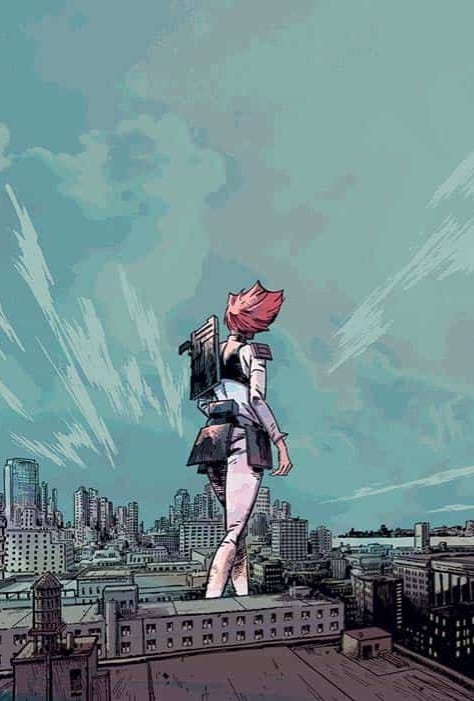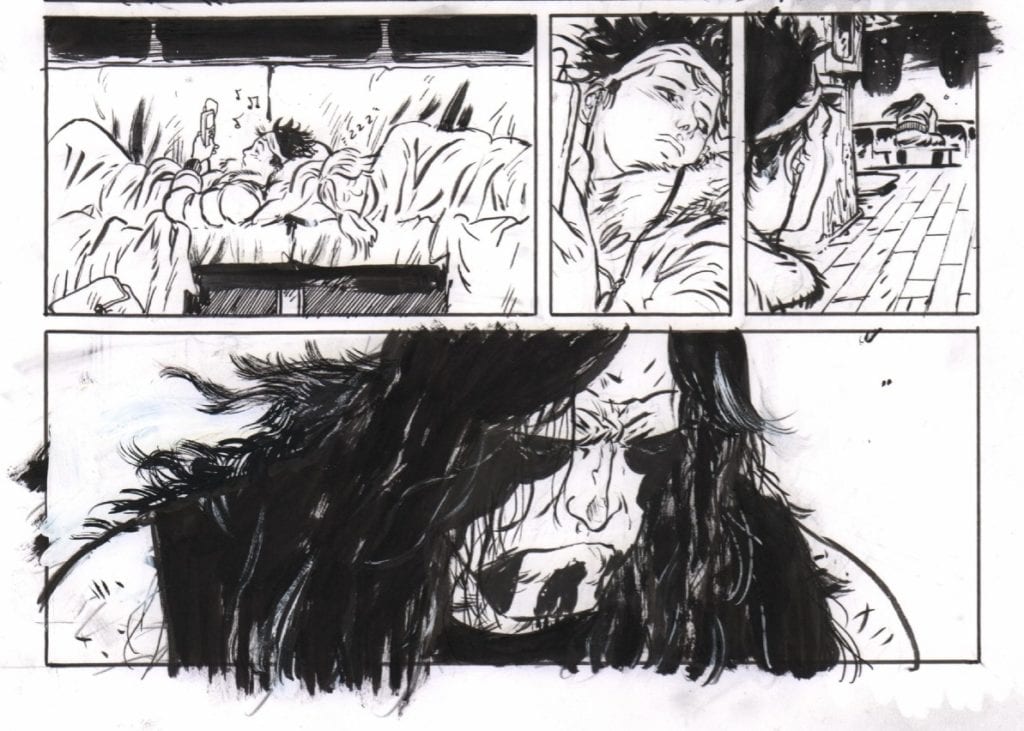They say that with comics, there is no budget, that you can do whatever you want and not have to worry about the logistics of creating it on the page. This is probably said more by writers than artists, but in essence, the idea is true. A comic is only limited by the imagination of the creators. This means that there are some comics with ludicrously outlandish concepts out there, way beyond the simple ideas of people with superpowers, able to fly or shoot lazy blasts from their eyes. A character like Deadpool may seem like a fantastical notion, with his constantly healing body and fourth-wall-breaking puns. Still, compared to the mind-boggling, dimension-hopping in Simon Spurrier and Rachael Stott’s Motherlands, he appears rather ordinary and straight forward.
Whether it’s the characters that are absurd, like the over evolved animals of The Superannuated Man, or the story itself, refer to Daniel Warren Johnson’s Murder Falcon, ludicrous ideas can form the backbone of a comic, but that does not make it unreadable or lacking in worth. Some of the more poignant comics from the last one hundred plus years have a concept that appears baffling at least. You only need to look at Art Spiegelman’s Maus to see how a seemingly ridiculous idea can become a work of art. A story about Jewish persecution told using Mice and Cats? If anything, it sounds like a joke and one in poor taste at that. But Maus is a seminal work of Art and recommended reading for all comic book fans.
In comparison, Jason Howard’s upcoming comic from Image, Big Girls, is as much a joke on paper as Maus might appear. Set in a near-future world where giant monsters regularly stomp through downtown American, the only line of defense is a group of giant women controlled by a defense organization called The Preserve. I would argue that such a pitch has limited appeal. However, like so many things in the world of comics, there is so much more going on in this title than making a ‘sexy’ Godzilla.
MFR ON YOUTUBE (latest video)
Help us reach 5K Subs!

Drawing In The Reader
As with any medium, the success or failure of a comic rests on the creator’s abilities to engage the audience. The plot can revolve around anthropomorphic beings dealing in mythological real estate, but if it is written well, a reader will find an element of identification. A small morsel is all that is required to entice an audience in and get them hooked into the story.
The easiest way to engage a reader is to give them empathetic characters. The most relatable element of any story is the cast because, as a reader and a person, we can identify with emotional reactions. The more outlandish the story, the more critical it is to have a grounded central character. This is why most superheroes or adventurers have sidekicks. They act as our entrance into the world depicted on the page.
Howard has set himself a mammoth task with Big Girls. Not only is he drawing the series, but he is writing it as well. Not only has he created a Western Kaiju but also a social discourse on genetics and procreative control. From the very beginning, Big Girls is an alien environment packed with a mixed iconography. The reader is thrown directly into the melee, with a coordinated operation involving The Preserve defense team, but Howard does not overwhelm his audience. Instead, he uses the chaotic opening to give the reader exactly what they need to navigate the story that follows: an empathetic hero.

Capturing Character
The opening page of Big Girls portrays a shadowed landscape that is instantly recognizable as a modern urban dwelling. There are hints that this is not an idyllic place: a plume of thick smoke drifting over the city, a closer inspection of the buildings reveals some to be in disrepair. Cemented into this image are four panels featuring people running in fear. Across the top of this scene of terror is a voice-over which, by page three, the reader comes to understand is the central character, Ember.
The voice-over is Howard’s first step in integrating the reader into the story. The tone of the speech is down to Earth. The speaker endears herself to the reader by referring to things that we would understand but also by creating an ‘every person’ image. She does not pretend to understand the complex science behind the event she is discussing or to have any insider knowledge. She knows what anyone on the street would know, and this comes across in the way she words her explanations.
When Ember is finally introduced visually, it is with a head and shoulder shot on a featureless background. She appears to be a normal woman. The clothing she wears isn’t too exotic, and even the communications device she wears around her neck is instantly understandable. Howard reinforces the idea that Ember is just like us by making this mission her ‘first,’ as explained in the speech. As a reader, we are experiencing this world for the first time, just as Ember is doing something new. Howard creates a bond between character and reader, an experience that we can share together over the following pages. From the first panel on page three, we know that what we are about to see is new to us but also, to a large extent, new to Ember as well.
Howard leaves the reveal of Ember’s size until the next page, by which time the reader has already accepted her on an emotional level. We have connected with her personality and the normal-ness that she has displayed. When the reveal comes, it is like a ‘wow’ moment. Her stature is impressive, and we are suddenly looking up at her in wonder. However, there is no sense of fear; she is not portrayed in a threatening light. In fact, the way Howard draws Ember reinforces what we have already learned about her on the previous pages.
Ember is stood casually at the end of the block with one hand on her hip. Her uniform is mostly white, which catches the sunlight making her a bright beacon in the panel. Her fiery red hair finishes off the image. She stands tall and proud with a smile upon her face. The way Howard draws Ember at this moment makes it impossible not to like her. The other characters on the page are small and mostly featureless, but Ember stands out, warm and welcoming.

Reinforcement and Horror
As The Preserve operation progresses, Howard continues to grow Ember’s character and personality by contrasting her against the other characters and by constant reinforcement of her gentle nature. This issue builds her up to be a gentle giant in a harsh, unrelenting world.
The main comparison that Howard draws is between Ember and her onsite handler James Tannick. Tannick is the opposite of Ember. He is ‘normal’ sized, experienced at his job, and blunt to the point of being rude. When he confronts Martin Martinez, the subject of the operation, he is insulting, aggressive, and like all bullies, he surrounds himself with colleagues to give him the advantage. He shows no compassion towards Martinez or his son. In fact, his brutal actions makeup one of the most shocking moments of the comic and help establish another aspect of Ember.
Her reaction to the violence she witnesses is as shocking and heartfelt as the readers. The horror on her face and the depression that follows is precisely how Howard wants the reader to react. In the opening pages, the audience is imprinted on Ember so that as the narrative progresses, we follow her and become sensitive to her side of the story. It’s difficult to root for the organization, even when you factor in their ‘for the greater good’ arguments because our entry into this world is through Ember, a character disgusted at the actions of her boss.
From this point onward, we have a center to the narrative, a character to rely on and root for. When anything starts to become outrageous or unfathomable, we can turn to Ember for guidance. Howard pins his outlandish story to the ground with Ember, giving us a solid foundation to watch the mayhem.

Conclusion
In Murder Falcon Daniel Warren Johnson was able to ground his story of Heavy Metal demon fighters with a central character suffering from a terminal illness. His pain and struggle is something that most readers can identify with making it easier to accept the rest of the story, no matter how bonkers it gets
With Brian K Vaughan and Fiona Staples’ Saga it is the down to Earth situations that the characters find themselves in that becomes the foundation of the comic. Falling in love, finding a babysitter, arguing with family, all of these things are commonplace across the world. It doesn’t matter who is falling in love; an alien, ghost, or robot with a television for a head, the process, and emotional reactions are the same.
Howard has a very firm understanding of this process of creating a solid foundation from which the readers can view the rest of the narrative. In Big Girls, Howard decides to use emotional response, and his lead character, as that foundation, that solid rock for us to hold onto throughout. He successfully establishes Ember in the opening page, and through that initial engagement, he can draw us deeper and deeper into his wild ride.

